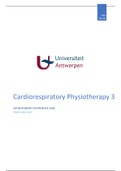Resume
Samenvatting 1MA cardiorespiratory physiotherapy 2 - Physiotherapy in the ICU
Samenvatting 1MA revalidatiewetenschappen en kinesitherapie, cardiorespiratoire physiotherapy 2.
Onderdeel: Physiotherapy in the ICU
[Montrer plus]
Publié le
1 février 2021
Nombre de pages
122
Écrit en
2020/2021
Type
Resume
S'abonner
€4,29
Egalement disponible en groupe à partir de €8,39
Garantie de satisfaction à 100%
Disponible immédiatement après paiement
En ligne et en PDF
Tu n'es attaché à rien
Document également disponible en groupe (1)
€ 18,45
€ 8,39
5 éléments
1. Resume - Samenvatting 1ma cardiorespiratory physiotherapy 2 - normaalwaardes icu
2. Resume - Samenvatting 1ma cardiorespiratory physiotherapy 2 - cardiac rehabilitation
3. Resume - Samenvatting 1ma cardiorespiratory physiotherapy 2 - ecg
4. Resume - Samenvatting 1ma cardiorespiratory physiotherapy 2 - physiotherapy in the icu
5. Resume - Samenvatting 1ma cardiorespiratory physiotherapy 2 - respiratory physiotherapy
Montrer plus
1MA





